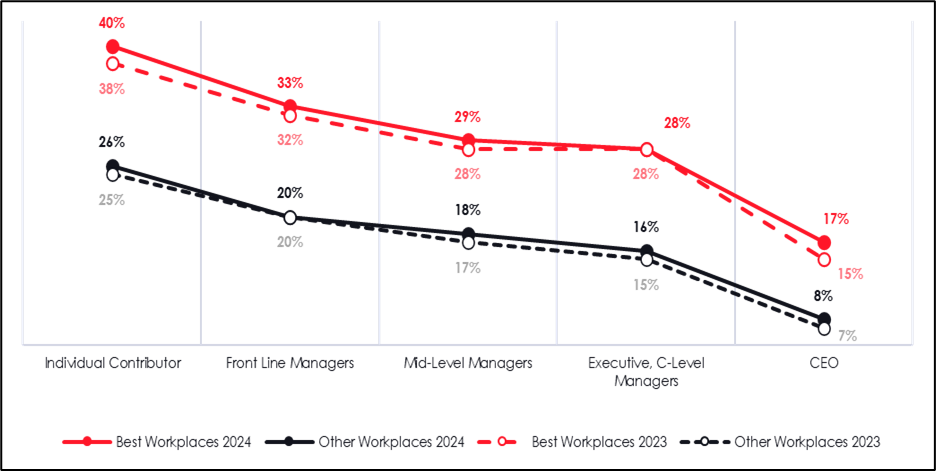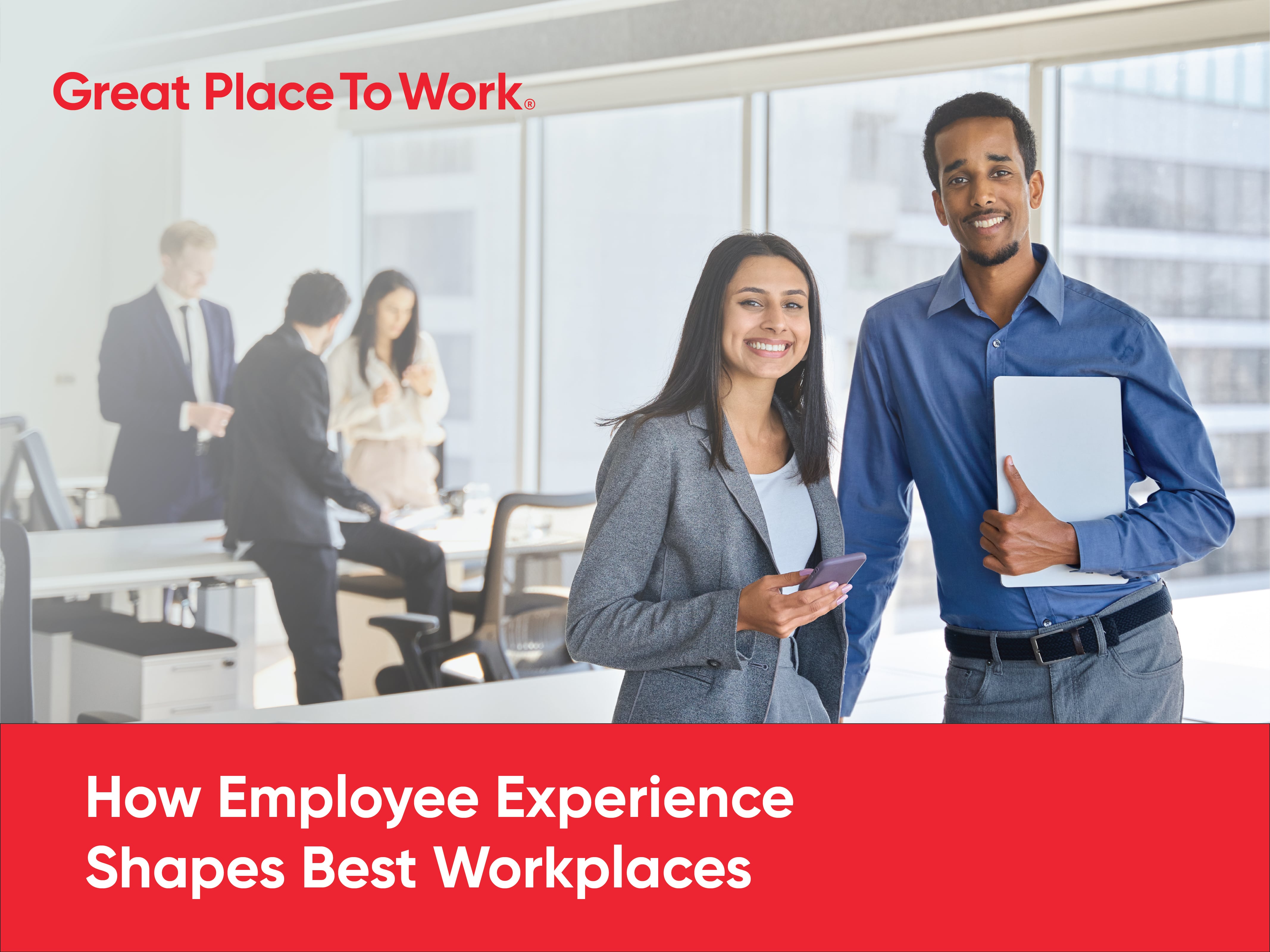Reading Time: 5 minutes
As the world unites to celebrate International Women’s Day on March 8, 2025, a glaring reality checks our progress: Indian women in the workplace still face an uphill battle for equity and opportunity. Despite growing conversations around diversity and inclusion, systemic barriers limit women’s growth and opportunities. According to India’s Best Workplaces for Women 2024 report, women make up 26% of the workforce, yet only 16% break the glass ceiling to rise to executive roles. This stark drop highlights the need for more equitable workplaces where women can thrive at every stage of their careers.
Women’s experiences across different career stages show that while their aspirations evolve, common themes emerge around recognition, growth, and the need for support systems. Addressing these needs is not just a moral imperative, it’s a business one.
We analyzed feedback from over 12 lakh women in India’s largest study on Best WorkplacesTM for Women and bring to you a powerful reflection of their experiences, aspirations, and challenges. Across role levels, their voices highlight what they need to thrive, and the barriers that hold them back.
What Early-Career Women Want: Security and Opportunity
As women embark on their professional journeys, they’re not just looking for a job – they’re seeking a foundation for lifelong growth, development, and fulfilment. At the start of their professional journeys, women prioritize job security, work-life balance, and opportunities to develop new skills. They seek stable environments where fair treatment and timely salaries are non-negotiable. Yet heavy workloads, limited training opportunities, and lack of recognition often stifle their potential.
Companies must invest in structured training programs and clear growth pathways to nurture this talent. Fair evaluations and consistent rewards can go a long way in making women feel valued and motivated. Workplaces should not only provide employment opportunities but also lay a foundation for future growth.
What Women Supervisors Want: Fairness and Autonomy
As women rise to supervisory roles, they’re expected to lead, inspire, and deliver results. Their focus shifts to autonomy and equitable advancement. They expect opportunities to influence processes and make decisions while being treated fairly. However, unclear promotion pathways, lack of mentorship, and limited decision-making authority often create frustration.
Organizations must empower women at this level by offering leadership development programs and transparent performance evaluations. Ensuring women have a voice in shaping team outcomes fosters ownership and drives engagement.

What Women Managers Want: Visibility and Growth
For women managers, visibility and recognition become essential. They want their ideas heard and their contributions acknowledged without bias. Yet inconsistent access to strategic projects and departmental disparities often limit their ability to advance.
Creating a great workplace for women managers means ensuring equal access to high-impact opportunities and unbiased performance recognition. Sponsorship programs, where senior leaders actively advocate for women’s growth, can help them gain the visibility needed to break through organizational silos.
What Senior Women Leaders Want: Influence and Equity
Women aspire to shape strategy and drive organizational impact at the senior leadership level. They seek opportunities to lead high-impact projects and representation in top leadership. Yet the glass ceiling remains a formidable barrier, with women’s representation dropping 11% from mid-level management to C-suite positions.

To address this, companies must prioritize building strong leadership pipelines and providing high-impact opportunities. Ensuring women’s equal representation in decision-making forums and executive roles will create a more balanced and innovative leadership team.
The Glass Ceiling: A Barrier Yet to Be Broken
Despite their achievements, women still face significant barriers when moving into senior leadership. The steep drop in executive-level representation points to systemic issues like unconscious bias, lack of mentorship, and limited access to high-visibility roles.
Breaking this glass ceiling requires intentional strategies. Companies must identify and address the structural challenges preventing women’s advancement and ensure high-potential women receive the sponsorship and visibility needed to move into leadership roles.
Addressing the Barriers: What Companies Must Do
Creating equitable workplaces requires a multi-pronged strategy, focused on building sustainable support systems for women at every career stage:
- Returnship Programs: Offer structured opportunities for women on career breaks to re-enter the workforce, including flexible roles and targeted upskilling initiatives.
- Diversity-Focused Hiring: Ensure job postings use gender-neutral language and leverage women’s networks and communities to attract diverse candidates.
- Equitable Growth Opportunities: Provide women equal access to leadership development programs, mentorship, and high-visibility projects across roles and locations.
- Flexibility and Support: Institutionalize policies like flexible work arrangements, childcare support, and extended parental leave to help women balance personal and professional priorities.
- Leadership Accountability: Tie diversity and inclusion metrics to leadership performance evaluations and set measurable goals for women’s representation and engagement.
- Recognition and Visibility: Celebrate women’s achievements and share their success stories to inspire and attract future talent.
This holistic approach ensures that women remain in the workforce and thrive and grow into leadership roles.
The Business Case for Women in Leadership
The evidence is clear: companies that prioritize gender inclusion outperform their peers. India’s Best Workplaces for Women 2024 report reveals that inclusive workplaces drive stronger employee engagement, higher customer satisfaction, and greater brand loyalty. When women feel valued and empowered, they catalyze growth, driving retention, performance, and motivation.
Beyond diversity targets, organizations investing in gender equity gain a clear business edge. Inclusive workplaces drive innovation, improve decision-making, and create a culture of trust. Companies that actively support women don’t just build better workplaces — they build stronger, more competitive businesses poised for long-term success.
A Call to Action for Leaders
This International Women’s Day, it’s time to move beyond symbolic gestures and commit to real change. Building equitable workplaces requires more than policy statements — it demands intentional action and accountability. Leaders must champion women’s advancement as a strategic business priority, not just as a diversity goal.
As we strive for a more equitable workplace, let us recognize the transformative power of collective action. We can achieve remarkable things when we come together to challenge systemic barriers and champion women’s advancement. The future of work belongs to organizations that invest in women leaders today. Will you be part of this movement?
Get Certified to Showcase Your Commitment
Achieving Great Place To Work Certification™ is an excellent way to demonstrate your organization’s commitment to employees’ overall well-being and experience. This Certification not only enhances your employer branding but also helps attract and retain top talent. It highlights to current and prospective employees that your organization values their overall well-being, fostering an environment where they feel appreciated and supported.
By implementing a culture of trust, respect, and collaboration, you can create a workplace where employees feel valued and connected. Certification also provides a benchmark for continuous improvement, helping you identify areas where you can further enhance employee well-being and overall workplace culture.









